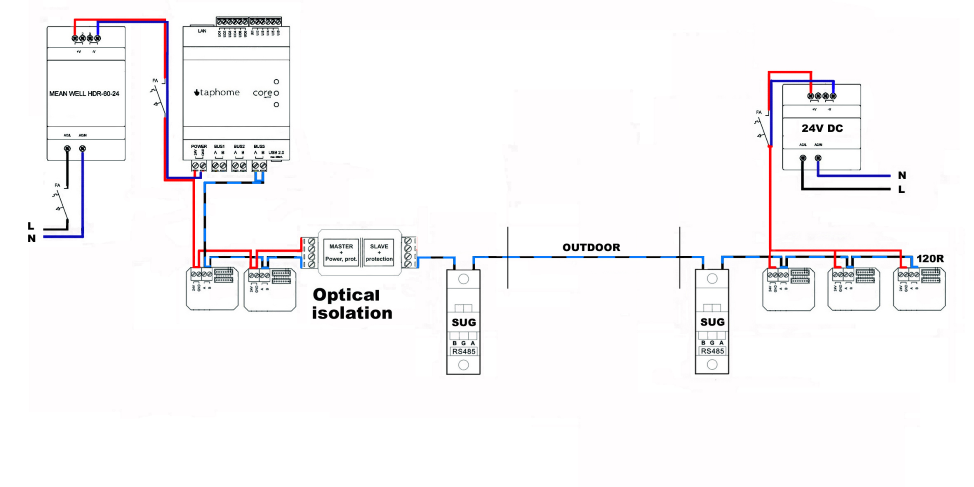- • Requirements for the controlled devices
- • Dashboards, Zones, Categories
- • Simple thermostat with hysteresis
- • Simple Heating management using Weekly schedule and Presence switch
- • Power limiting
- • Notification on high temperature (DEPRECATED)
- • Configuring hysteresis control via Equation Smart Rule
- • PID Temperature regulation
- • PID Cascade
- • Regulation of Boiler Cascade
- • Equithermic regulation
- • Heating control in high electricity tariff via load management tariff indicator input
- • Heating and Cooling modes
- • Editing multiple devices at once
- • Setting the response speed of push buttons
- • Integrate multiple control units Core
- • Safe values
- • How to combine two daily schedules in one day
- • Linking devices together
- • Device log
- • Using statistic values in Smart Rules
- • Hot water circulation pump control
- • Exporting data from TapHome into Google Spreadsheet using Integromat
- • Exporting device descriptions
- • 2025
- • 2024
- • 2023
- • 2022.2
- • 2022.1
- • 2021.3
- • 2021.2
- • 2021.1
- • 2020.1
- • 2019.1
- • 2018.1
- • 2017.1 - Blinds automation - angle control update
- • 2017.1 - Blinds automation - Depth of sun rays
- • 2017.1 - Charts updated
- • 2017.1 - Core update from the app
- • 2017.1 - Double click and triple click
- • 2017.1 - Expose devices
- • 2017.1 - Multi-value switch
- • 2017.1 - Permissions
- • 2017.1 - Replace module action
- • 2017.1 - Set to Automatic mode - "Push buttons event" Smart Rule
- • 2017.1 – Daily schedule Smart Rule
- Documentation
- Wiring info and examples
- Surge protection
Surge protection
For a bus pulled through the exterior or through a space that is not in the protection zone of the lightning conductor system, we recommend using a surge protector, a voltage arrester for the RS-485 bus. Unlike bus isolators, surge protection raises the induced voltage to the PEN / PE terminal, thus protecting the input circuits of your equipment. When using the connection on the enclosed diagram, it is not necessary to protect the PLUS pole of the power supply, as it is assumed that the power supply is located in a protected area. However, if this is not the case, it is also necessary to use surge protection for 24V DC distribution and it is also suitable to use type C protection on the AC supply side. However, the construction of the duct itself depends on the cross-section of the LV distribution cable and the possibility of using the system ground. In the diagram, the surge protection is used only on the supply of the remote part in the exterior. It is only a half-way solution for bus protection.

A full-fledged solution of bus protection passing through parts that are and consequently not in the protection zone of lightning conductor systems (or in their parts) where it is theoretically not possible to absorb the energy field created by atmospheric discharge requires the use of two surge protectors at line inputs to protected zones. Regardless of whether or not an optical isolator was used on the bus.

For a bus pulled through the exterior, which is not in the protection zone of the lightning conductor system, we recommend using a surge protector, a surge arrester for the Modbus bus as well. When using the wiring in the enclosed diagram, there is no need to protect the PLUS pole of the power supply, as it is not used. With the right project, it is necessary not to neglect the risk of electromagnetic impulse from atmospheric discharges in accordance with the set of standards STN EN 62 305. The diagram shows the full protection of the Modbus line, equipped with surge protection on both sides of the bus conductor.

Surge protection for temperature measurement
If the temperature measurement is performed using a temperature-dependent resistor, such as Pt 100, the ohmic part of the additional cables as well as the damping resistors of the protective devices must be taken into account. In the case of a two-wire measurement, the SPD resistance value may distort the measured result. For example, if the sum of the damping resistances in the measured circuit is 4 ohms, then the measurement error is 4% for a 0 ° C measurement, because 104 ohms are detected instead of 100 ohms. For this reason, two-stage protection circuits are available as a version without damping resistors to minimize the impact of SPD in such an application.
Surge protection for current loops
The measured values are usually transmitted using standardized field processes. The 4 to 20 mA signal is mainly used in applications where longer wires are used. The measured value on the sensor is converted to the current value running between the two transmission devices. The ohmic resistance of the cable has no effect on the measured current transfer current. For current loops, two signal conductors are often used, which do not require an additional reference potential and are routed in an isolated state from the ground potential. SPD at both endpoints is required to protect this type of application from transitions. The relevant SPD is equipped with a multi-stage protection circuit. Normal mode transients between the signal wires and normal ground voltage are the result at both endpoints.